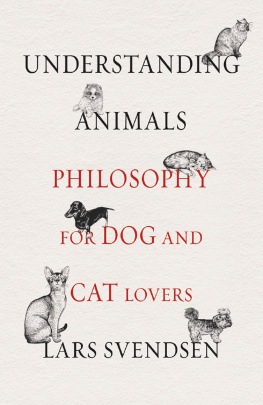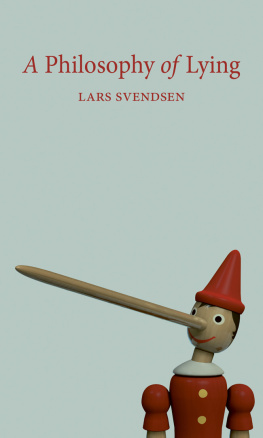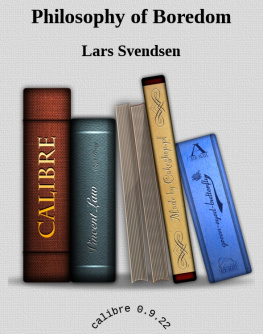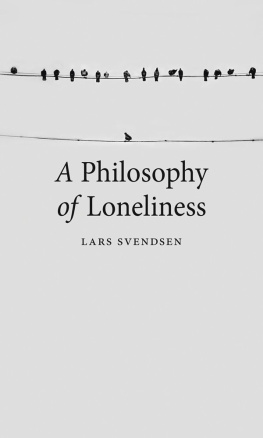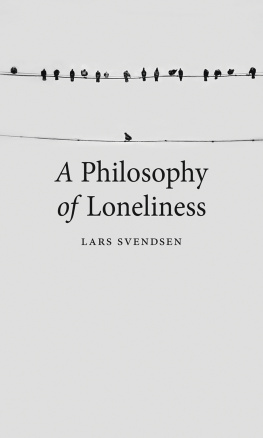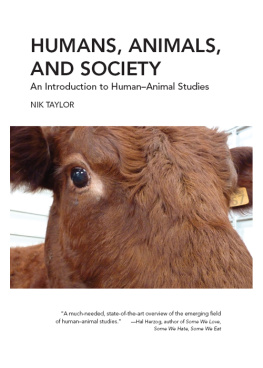UNDERSTANDING ANIMALS

Others books by Lars Svendsen also published by Reaktion Books:
Fashion
A Philosophy of Boredom
A Philosophy of Fear
A Philosophy of Freedom
A Philosophy of Loneliness
UNDERSTANDING
ANIMALS
Philosophy for
Dog and Cat Lovers
Lars Svendsen
Translated from Norwegian
by Matt Bagguley
REAKTION BOOKS
To Kari Hndler Svendsen (19442017),
who taught me how to understand animals.
Published by Reaktion Books Ltd
Unit 32, Waterside
4448 Wharf Road
London N1 7UX, UK
www.reaktionbooks.co.uk
This edition first published 2019
Copyright Lars Fr. H. Svendsen. First published by Kagge, 2018.
Published in agreement with Oslo Literary Agency.
Matt Bagguley asserts his moral right to be identified as the translator of the work.
This translation has been published with the financial support of NORLA
All rights reserved
No part of this publication may be reproduced, stored in a retrieval system, or transmitted, in any form or by any means, electronic, mechanical, photocopying, recording or otherwise, without the prior permission of the publishers
Printed and bound in Malta by Gutenberg Press Ltd
A catalogue record for this book is available from the British Library
eISBN 9781789141870
Contents
Introduction
A nyone who has ever had a pet has wondered how the animal perceives the world, or how it feels to be in the world of a dog or cat, for example. No dog or cat has ever written an autobiography telling us anything about it. When I see a moose, fox or hare on a woodland road, I wonder how they perceive me. When we see nature programmes on TV where an eagle glides, a killer whale swims or an octopus walks on the seabed, we try to imagine what its like to be in the consciousness of these animals. American biologist Stephen Jay Gould writes:
Give me one minute just one minute inside the skin of this creature. Hook me for just sixty seconds to the perceptual and conceptual apparatus of this other being and then I will know what natural historians have sought through the ages.
It is, as Gould somewhat mournfully points out, impossible. We can do nothing more than work indirectly, study these creatures from the outside and always remain in wonderment at what actually goes on in their consciousnesses, and how it is to be present in the world of one creature or another.
If my approach in this book can be linked to a particular philosophical tradition, it is the hermeneutic tradition. This might seem strange to anyone familiar with this tradition, since it has typically dismissed animals from the domain of understanding, claiming that animals are something that can only be explained, not understood. One goal of this book is therefore to draw animals into hermeneutics, or the theory of interpretation; something from which they have traditionally been excluded.
In studies of animal mental life, chimpanzees and pigeons are over-represented. Cats and dogs show up far less often, but there is also an exhaustive amount of literature on them. In this book, there will be a lot about cats and dogs because they are the animals most of us are closest to in our daily lives. Chimpanzees are far closer to us genetically and evolutionarily, but very few of us have a chimpanzee at home, something which both chimpanzees and humans should be happy about. The proportion of cat and dog researchers who have all their fingers intact is far higher than that of chimpanzee researchers. Cats and dogs are more at home in our lives than chimpanzees are. This book will make good use of the observations I have made of my own cats and dogs particularly Luna the dog and the cats Lasse and Geir, who will feature regularly in the text for the simple reason that you learn a lot about an animal by living with it for many years. Of course, many other animal species will be included, and since the book is called Understanding Animals, that understanding should be put to the test; so I have chosen to give a little extra attention to the giant Pacific octopus, an animal with an advanced consciousness. However, since it has less in common with us than most other animals, it presents a real challenge. Understanding an octopus is like understanding a visitor from another planet.
The motto of the SETI programme, which searches for intelligent life on other planets, is a question: Are we alone? Meaning more precisely: Are human beings alone, as intelligent life, in the universe? The answer to the question is evidently a resounding no! Admittedly, I am a little agnostic on the question of whether there is intelligent life, or any kind of life, on other planets. On our planet, Earth, there is plenty of intelligent life, in addition to the Homo sapiens sapiens species. While writing these lines, I am sitting in the family cabin, where I have retreated for a few weeks to write undisturbed. However, I am not completely undisturbed because I have no doubt at all that there are two conscious beings here, or two subjects if you like: my dog and myself. We go for a walk now and then, and chat a little. Its not like in the movie Cast Away (2000), where the protagonist, stranded on a desert island, draws a face on a volleyball, talks to it and calls it Wilson. The volleyball evidently has no consciousness but I have no doubt at all that my dog, Luna, does. That she is an example of intelligent life is obvious, but I ask myself, can I understand this variant of intelligent life that is quite different to my own? Can I understand Luna? Can I understand what its like to be her?
This is a philosophical analysis of our relationship with animals. The purpose is to use philosophical perspectives which the individual reader may include in their own reflection of our relationship with animals. Ludwig Wittgenstein wrote: Work on philosophy... is really more a work on oneself. On ones own conception. On how one sees things. (And what one expects of them.) Self-reflection like this cannot be done for you. You have to do it yourself. Rather than giving clear answers, I hope that I can, above all, contribute to the reader seeing something that would otherwise have been overlooked; and think thoughts that might have remained unthought.
ONE
Wittgensteins Lion and Kafkas Ape
I f a lion could talk, we could not understand him. Ludwig Wittgensteins assertion strikes us as strange. Most of us think that if an animal could speak, we would understand it. The lion would then be able to tell us what its like to be a lion, instead of us having to deduce it from the lions behaviour. What does Wittgenstein really mean by this remark? What kind of language did he imagine this lion would speak? German? English? Lionish? If he means to say that the lion speaks, but that it speaks Lionish, a language we do not understand, then it goes without saying that we would not understand it. On the other hand, he could also have said: If a Maasai can speak, you cannot understand him. That is obvious, since Im no expert in Maasai. But Wittgenstein seems to be trying to say something more than simply the tautological claim that one cannot understand languages one does not understand.
More precisely, one can imagine that he wants to highlight a chasm between the humans world and the animals a chasm so deep that understanding would be impossible, even if, for arguments sake, we assumed that the animal could speak a language that consisted of the same words and the same grammar as English, for example. Of course, I have never met an animal that speaks, if speaking means speaking like humans do, for the simple reason that no animal other than humans speaks like humans do. On the other hand, I have never interacted with an animal that did not speak. I have seen animals that do not speak, but these have been ones I have never been actively involved with. When I have encountered animals that I have tried to understand, they have spoken without exception, but of course it is me who has spoken for them. When I have tried to understand what is happening in the animals consciousness, I have been unable to avoid articulating this understanding linguistically, as if it were the animal itself that spoke. I too am speaking to the animals. Not because I suffer from any illusion that the animal understands my sentences, as other people understand them, but because that is the way I communicate, and it seems as if I manage to communicate

